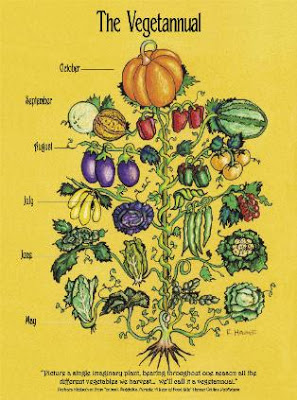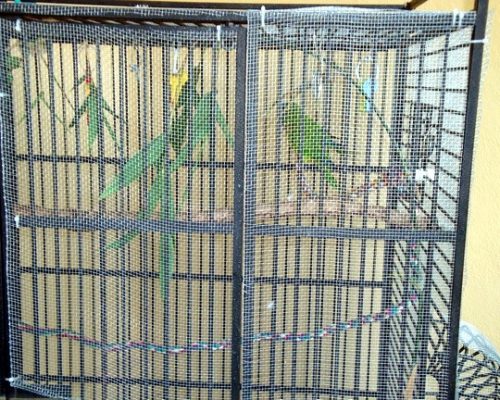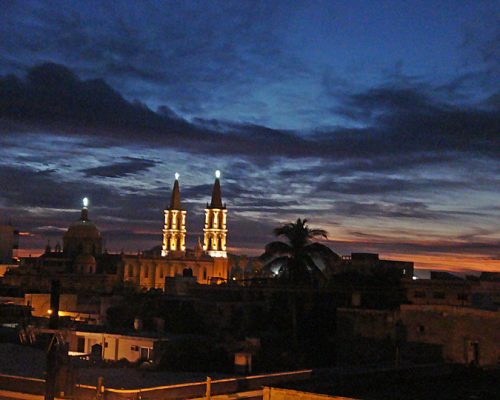Gas costs a lot. Refrigeration costs a lot. Loading and unloading do, too. So it makes a lot of sense – even in just financial terms – to eat food that is grown locally. A lot of people are beginning to question our desire for out of season foods – why eat strawberries in January in Seattle when they’ll be fresh in May? Especially if they’ll have to be shipped from South America? How good can they taste after travelling for weeks?
I just finished reading Barbara Kingsolver’s book Animal, Vegetable, Miracle. She and her family set out to prove to themselves that they could eat from within 100 miles of home – with only a few exceptions. (Olive oil and flour for example) They grew a huge garden, raised chickens and turkeys, and bought the rest of their meat from local farmers. No more asparagus in winter for them!
I love buying produce here. But I am struggling to figure out what the seasons are for produce. Mangos and avocados I know – I see the trees around here and can watch the fruit ripening.
Being in a new climate has raised hell with my preconceptions of seasons. When are Mexican strawberries locally available? How can I do my part in buying locally grown produce without the basic schedule in my new environment? I haven’t had any luck Googling, so I will need to talk to the fruteria owners and read whatever labels I can find. Even in our mercado you will see apples with stickers from Washington State!
I know Mexico values the US market for their produce, but the whole transporation issue means that it won’t be the last time tomatoes or jalapenos or cilantro are suspected when illness strikes.
When food is being transported a long way, varieties are selected based on how well the produce travels and how uniform its shape is. This isn’t a new concept. I remember that my father (a food consultant) was interviewed in 1974 lamenting the loss of taste in tomatoes which were being bred for their square shape and thick skins.
In the US, the Slow Food movement, the Locavore movement, and the proliferation of farmer’s markets and organic produce create a support network for people who would like to eat good, tasty food that grew nearby. Heirloom varieties are sought after for their taste and their seeds that grow true to the parent.
Here in Mexico, we can buy from our local fruteria or mercado whenever possible. I occasionally see organic produce in the supermarket, but unfortunately it usually looks pretty unappetizing. Until I figure out the harvest schedule in our area Paul and I plan on driving into the countryside occasionally where you’ll see heaps of watermelons or other produce being sold from a stand or back of a truck.
How else can we buy the best produce? How can we understand the use of pesticides in an individual crop? Is there a movement here brewing that will reduce the use of pesticides and even maybe embrace organic growing? Do any readers have sources they can share with information that would help me sort this out?





Billie
July 27, 2008Over time we have found a couple of organic farms near SMA and have figured out where they sell their produce in town since we can’t always get out to the farm. I think if you keep asking around you’ll locate some sources. Of course our organic farms may be the result of a higher enough volume of gringos and restaurants in town who will pay a little extra for the organic grown produce.
mcm
July 27, 2008Nancy — this is a great topic. Many folks arrive in Mexico and assume that because they are buying from a small or local market or tienda, rather than a supermarket, they’re buying “locally grown” produce. This is probably not the case, at least in most parts of the country. Local businessman go to supply centers early in the morning, and stock up. Even when you go to the “countryside” and buy from trucks, it’s not always the case that those trucks are carrying “locally” grown produce — although again, this depends on where you live.
Also, some large supermarkets DO buy locally — a chat with the produce people at the supermarket may give you valuable information.
Asking around will help, always keeping in mind that some of the responders will tell you what they think you want to hear, rather than “the facts”.
Likewise, as you point out, “organic” just isn’t a big thing here, and chemical fertilizers and pesticides seem to be the rule, even for the smallest operations.
1st Mate
July 27, 2008Good idea, and I’m inspired to at least make some changes in my buying habits.
But I draw the line at raising my own meat. I’ll go vegetarian like you before I do that.
Jonna
July 27, 2008This idea, to eat from within 100 miles, is restrictive but at least reasonable down here where there is an abundance of fresh food all year. Where I think it breaks down and really returns people to the dark ages is when it is proposed for people in the freezing north. I don’t think it is an improvement on anything for people to have to go back to eating roots, no fruit and canned veggies when they could have fresh. Sorry, it just sounds really regressive to me.
Nancy
July 27, 2008Billie – I am going to ask a couple of restaurant owners I know what they know about the availability of organics, good tip.
MCM – Where do you live ? I see your comments here and there and have always wondered. I will talk to the supermarket guys if they will be patient with my slow Spanish!
Bliss – The book just made me think – no need to go vegetarian, now!
Jonna – I think I must not have explained my idea well – I never intended it to be a post about what anyone SHOULD do. To each his own, in my book. And it would be challenging to do 100 miles in the North, for sure. It just made me think about how I have no idea where the food here comes from, and I want to.
No one answered my main question, which was what are the food cycles here in Mexico? I was a gardener up North so I know when Peas are fresh, or Corn, or whatever. Here the climate is so different I am clueless. And for me that’s the first part of buying locally grown food – you need to know when it would be ripening here.
Jonna
July 27, 2008Oh Nancy, I didn’t mean that to sound personal. A while back there was this guy in New York who was in all the papers as he spent a year eating only local foods along with his poor kid and wife. Well, maybe not so poor. He got a big book deal which seemed to be the point of it all to me. I thought he really pretentious and just generally disliked everything I read about him. It carried over to the whole concept for me.
Michael
July 27, 2008I think I saw the “Vegetannual” growing in Haight-Ashbury in the 60’s. I might be confused as there were a few years that I am not too clear about. 😉
Nancy
July 27, 2008Jonna,
Hey I didn’t take it personally! I know what you mean about the author, I think I have read about him. The book and all the stuff I have read about the topic just really pointed out how clueless I am down here. I need to get educated about food and the growing season way more.
Michael,
I might have been in the Haight with you, or at the Fillmore or somewhere as I seem to recollect in the haze of those years living in SF too.
Nancy
jennifer
July 28, 2008Hi Nancy,
Here is some VERY general information for basic veggies for all of Mexico
http://mexicanfood.about.com/od/introtomexicanfood/a/seasons.htm
There are some good sites for the US though:
http://www.sustainabletable.org/shop/eatseasonal/
http://www.nrdc.org/health/foodmiles/
I don’t know if choosing Texas or Southern New Mexico might at least get you heading in the right direction.
Jennifer
Nancy
July 28, 2008Jennifer, thanks for the link, and also for the push to keep searching as I came across
http://www.producealliance.com/index.cfm?method=markRep
It’s a California produce group and their little narratives tell when each crop is plentiful etc. I am going to try to build a Mexico calendar myself from these.
Brenda
July 28, 2008The way we know what is in season locally is by the trucks that cruise through the neighborhood. 1/2 ton trucks full of 1 certain fruit or vegetable. They are always selling the surplus from the farms and it is always the stuff that is in season. Good buys at good prices. I have never kept track of what is sold when though, we just go with the flow and buy what is being sold.
Theresa in Mèrida
July 28, 2008This is so timely for me. I write a weekly food column for Yo Listo (a Yucatan forum) and one of the readers just asked me when different fruits and such are in season. I honestly don’t know since I just buy what is being sold! I don’t worry about it otherwise.
regards,
Theresa
Nancy
July 28, 2008Theresa,
I have been in touch with Cristina at Mexico Cooks and have found a few websites to help me put together a harvest calendar. When I get it done I’ll share it on the blog.
This is a good website with some state by state info for Mexico. Click on Produce Varieties.
http://www.freshfrommexico.com/
Nancy
July 28, 2008Theresa,
I forgot, I’m going to go check out your column at YoListo!
Nancy
Nancy
July 28, 2008Brenda,
I wish we had these trucks in Centro. It is probably something either smaller cities have or maybe in the colonias, but I don’t see them here.
We’re four blocks from the main mercado, that’s probably why.
Take care,
Nancy
Beth
July 29, 2008I loved this post.
I truly believe that buying locally is not only a much more flavourful way of eating, but a great way to support the local economy. I hate to go into the big grocery stores here and see that more than 3/4 of the available produce was grown in the US and other countries and then shipped here. The taste is gone from the foods and you’ve got to wonder how much “stuff” was srayed into/onto the food to keep in a semi-fresh state until it’s arrival in Canada. Not to say that the big sotres don’t get local produce, but the majority is shipped in. During the growing season, you’ll still see tomatoes that have been shipped in from the US, when tomotoes are growing rampant in people’s gardens!
The “chef” who runs the cafeteria here at the hospital where I work has actually decided to buy as much local food as possible. He was on the local news and in the newspaper, like this was some sort of new idea. LOL God bless him though!
CancunCanuck
July 29, 2008Nancy- I wish I could shed some light on the topic, but I just go by what’s on the shelves too! I did want to note that our doctor has told us to never eat Mexican strawberries. Fresh or not, he said they are all bad and are the cause of a lot of illness. He really recommended sticking to California strawberries (er, Cali to Cancun is a BIG distance!) or frozen ones. Too bad, I really do prefer to support local but I am sticking to the doc’s advice, he’s a specialist in infectious disease and he said he would never eat them nor would he give them to his children. (I know, someone is always going to question a Mexican doctor’s credentials, but this guy is tops, he lectures in the US frequently so I do not doubt what he says). Good luck, I look forward to hearing more about this, great post!
mcm
August 2, 2008nancy — I live in Yucatan, just outside of the city of Merida.
I THINK that harvest dates differ a lot for different regions of the country, just as in the US.
Here in Yucatan, for example, the intense spring/summer heat, and the dry season (November-May) determines the harvest dates for many crops. And, at least on a very local level (our garden and area) the weather (winter temps, and how much rain during the “dry” season, in particular) has a lot to do with when “backyard” crops are ready to harvest (mangos, avocados, pithaya, oranges, ciruelas, etc.). But, complicating that, more and more areas are introducing irrigation, etc.
I don’t know much about the agriculture of your area, but “eating locally” in Yucatan would entail a pretty radical shift in diet (forget potatoes, carrots, onions, for example).
American Mommy in Mexico
August 3, 2008I have been reading Barbara Kingsolver books this year. Good friend gave them to me when she moved. I really enjoy them. I will add this title to my list of books to read. I reccommend Prodigal Summer by her as well.